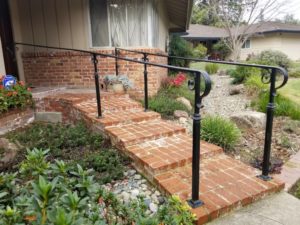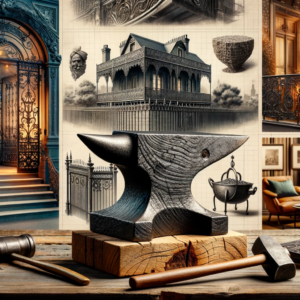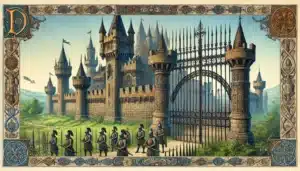They say a little knowledge is a dangerous thing. Well, in the world of metalwork, a little typo can be just as tricky. You’ve probably heard folks talk about ‘rod iron’ when they’re ogling over fancy gates or classic railings. It’s one of those mix-ups that’s enough to make any seasoned metalworker chuckle – or groan, depending on how long their day’s been.
Here’s the straight scoop: what most folks are calling ‘rod iron’ is actually ‘wrought iron’. Yeah, you read that right. It’s ‘wrought’, not ‘rod’. I know, I know, it sounds similar, and to be honest, I didn’t know the difference myself when I first started bending metal more than two decades ago. But trust me, in this business, words – like metals – have their own weight and worth.
Now, why does this mix-up matter? For one, knowing your materials is the bread and butter of our trade. Whether you’re a fresh apprentice or a seasoned veteran, understanding the difference is crucial. It’s not just about getting the terminology right; it’s about respecting the craft, the history, and the artistry that goes into working with these metals. For enthusiasts, designers, architects, and us folks in the forge, knowing your ‘rod’ from your ‘wrought’ isn’t just pedantry – it’s a nod to the rich tradition we’re all a part of.
The Origin of the Confusion
Digging into the history of wrought iron is like opening an old, heavy book filled with tales of fire, hammers, and the clang of the forge. Wrought iron’s story stretches back centuries, long before the first skyscrapers kissed the sky. This metal was the backbone of early industry, the stuff of weapons, tools, and later, intricate railings and gates that you’d see adorning Victorian homes. It was ‘wrought’ – worked, hammered, and twisted by the hands of skilled blacksmiths. Each piece was unique, marked by the sweat and skill of the person who made it.
But here’s where the wires got crossed. As time rolled on, and fewer folks knew a forge from a frying pan, ‘wrought’ became ‘rod’. Maybe it was easier to say, or maybe it just slipped into the common tongue that way, the way words do when they travel from ear to ear, losing a bit of their original shape. ‘Rod iron’ started popping up in casual conversation, in advertisements, even in design catalogs. It’s a classic case of a typo becoming almost as real as the real thing.
Language, like metal, evolves. ‘Rod’ is simple, straightforward – a piece of metal, long and round. But ‘wrought’? That’s a word with a story. It speaks of process, of effort, of craftsmanship. While a rod is just a shape, wrought iron is a testament to the process of creation. So, when we talk about wrought iron, we’re not just talking about a material. We’re talking about a heritage of craftsmanship, a tradition that’s been hammered and honed over centuries, surviving the heat of the forge and the test of time.
Understanding Wrought Iron
A. Definition and Characteristics of Wrought Iron
Wrought iron, in the simplest terms, is an iron alloy with a very low carbon content, making it tough, malleable, and rust-resistant. This isn’t your everyday iron. It’s something special, something that’s been worked on by hand and hammer. Its signature characteristic? A grainy texture, almost like wood, thanks to its siliceous impurities, known as slag. This slag gives wrought iron not just a unique look, but also a resilience that’s unmatched. You bend it, twist it, stretch it, and it still holds strong.
B. The Manufacturing Process of Wrought Iron
The process of making wrought iron is as much an art as it is a craft. It starts in a bloomery, a type of furnace where iron ore is heated up with charcoal. The heat and the carbon from the charcoal reduce the ore to a spongy mass called a bloom. This bloom is then hammered, and I mean really hammered, to drive out impurities and mix in the slag evenly. What you’re left with is a piece of metal that’s not just tough, but also ductile, meaning it can be shaped into just about anything a creative mind can imagine.
C. Historical and Modern Uses of Wrought Iron in Architecture and Design
Historically, wrought iron was the go-to material for everything from swords to plowshares. But where it really shines is in architectural and decorative work. Think of the ornate gates of old London, the intricate balconies in New Orleans, or the timeless elegance of wrought iron railings in historic districts worldwide. These aren’t just structures; they’re stories in iron.
Fast forward to today, and wrought iron still holds a special place in design. It’s the touch of class in a modern minimalist home, the nod to tradition in a contemporary office building, and the heart of bespoke, handcrafted furniture. In an age of mass production, wrought iron stands apart as a reminder of what human hands and imagination, coupled with a bit of fire and metal, can achieve.
The Beauty and Versatility of Wrought Iron
A. Overview of Wrought Iron’s Aesthetic Appeal
The aesthetic appeal of wrought iron is timeless. It’s the perfect blend of strength and beauty, ruggedness and elegance. The grainy texture of wrought iron, reminiscent of wood, gives it a rustic charm that can’t be replicated by modern metals. Its ability to be both strong and malleable means it can be twisted and turned into shapes that are complex and intricate, or simple and sleek. This versatility allows it to fit seamlessly into a variety of architectural styles, from the grandeur of historic buildings to the clean lines of modern designs.
B. Examples of Iconic Wrought Iron Structures and Artifacts
When we talk about wrought iron, certain images spring to mind. The Eiffel Tower in Paris, a marvel of engineering, is perhaps the most famous wrought iron structure in the world. Then there’s the intricate work on the gates of Buckingham Palace, or the ornate balconies of New Orleans’ French Quarter, which capture the soul of their respective cities. These aren’t just structures; they’re landmarks, symbols of their times, and testaments to the skill of the ironworkers who crafted them.
But it’s not just in grand structures where wrought iron makes its mark. It’s in the smaller artifacts too – the weathervanes that have topped barns for centuries, the garden gates that welcome you into a secret world, the candle holders that add a touch of elegance to any room. Each piece tells a story, a narrative of craftsmanship and style.
C. Wrought Iron in Contemporary Design and Decor
In the modern world, wrought iron continues to hold a place of honor. It’s found a new life in contemporary design and decor, bringing a touch of tradition to even the most modern spaces. You’ll see it in statement pieces like stair railings in a luxury condo, in the clean lines of a custom-made bed frame, or in the delicate swirls of a garden bench. Designers and homeowners alike turn to wrought iron when they want something that stands out, something that says ‘crafted’ in a world of ‘produced’. It bridges the gap between the old and the new, proving that some things – like the appeal of well-crafted metal – are truly timeless.

Rod Iron vs. Wrought Iron: Clearing the Confusion
A. Clarifying What ‘Rod Iron’ Mistakenly Refers To
Let’s get one thing straight: ‘rod iron’ is a bit of a misnomer. When people say ‘rod iron’, they’re usually trying to talk about wrought iron but have gotten tangled up in the typo. Technically, a ‘rod’ is just a straight, cylindrical piece of metal, which could be made from any kind of metal – not necessarily the low-carbon iron that characterizes wrought iron. So, when you hear ‘rod iron’, think of it as a linguistic slip-up, a mix-up in the melting pot of metal terms.
B. Technological and Qualitative Differences Between Actual Rod Iron Materials and Wrought Iron
Diving deeper into the materials, the differences become clear as day. True wrought iron, with its low carbon content, is tough, malleable, and resistant to corrosion. It’s unique because of its slag fibers, which give it a wood-like grain and an inherent resilience. On the other hand, a standard iron rod – if we were to use the term correctly – is just a basic form of iron, lacking the distinctive characteristics of wrought iron. It’s usually more brittle, less ductile, and doesn’t have the same rustic, handcrafted appeal.
C. How to Identify Genuine Wrought Iron Pieces
Identifying genuine wrought iron is part art, part science. First off, look for the telltale signs of traditional craftsmanship – irregularities in the metal, the presence of hammer marks, and the distinctive wood-like grain pattern. These are hallmarks of something that’s been forged by hand, not churned out by a machine. The weight of the piece can also give you a clue; wrought iron is denser and heavier than most modern steel. Finally, consider the context and history of the item. Genuine wrought iron is often found in older, historic pieces – gates, railings, tools – that have stood the test of time.
Understanding the difference between ‘rod iron’ and wrought iron isn’t just about getting the terms right; it’s about appreciating the artistry and history of metalworking. As we move forward, let’s keep this heritage alive by recognizing and respecting the true nature of wrought iron. In the next section, we’ll explore the cultural and artistic significance of wrought iron, and why it’s not just a metal, but a legacy.
The Cultural and Artistic Significance of Wrought Iron
A. Wrought Iron in Historical Contexts
The story of wrought iron is woven into the fabric of history itself. This material has been a silent witness to revolutions, changes in dynasties, and the rise and fall of empires. In ancient times, wrought iron was treasured for its strength and durability, often used in weapons and tools that enabled civilizations to grow and prosper. As time marched on, its role evolved from the purely functional to the highly decorative. The gates of palaces, the grilles of cathedrals, and the balustrades of grand estates bear testimony to this transition. In each era, wrought iron mirrored the prevailing aesthetics and technological advancements, becoming a physical embodiment of the cultural zeitgeist.
B. Its Role in Cultural and Artistic Movements
Wrought iron has played a significant role in various cultural and artistic movements throughout history. During the Gothic period, it was used to create intricate designs that complemented the soaring architecture of the time. The Renaissance saw a revival of classical motifs, with wrought iron being used in more symmetrical and proportioned designs. The Victorian era brought about a fascination with ornate and elaborate patterns, evident in the wrought ironwork of that time. Each of these periods used wrought iron in ways that not only reflected their distinct styles but also pushed the boundaries of what could be achieved with this versatile material.
C. Contemporary Artists and Craftsmen Working with Wrought Iron
The legacy of wrought iron continues today, championed by a new generation of artists and craftsmen. These modern-day blacksmiths blend traditional techniques with contemporary designs, creating pieces that are both innovative and steeped in history. They are not just preserving a craft; they are reinventing it for the 21st century. From functional art like gates and railings to purely artistic sculptures, these artists are exploring the endless possibilities of wrought iron. Their work is a testament to the enduring appeal of this material and its ability to adapt and remain relevant in an ever-changing world.
Maintenance and Preservation of Wrought Iron
A. Best Practices for Maintaining Wrought Iron
Maintaining wrought iron is all about regular care and attention. First and foremost, keep it clean. Dirt and debris can hold moisture against the iron, which can lead to rust. Use a mild soap and water to gently clean it, and make sure to dry it thoroughly. If you’re dealing with outdoor pieces, like gates or garden furniture, it’s wise to give them a once-over every few months to check for signs of wear or rust.
Regularly applying a coat of protective wax or a suitable paint can go a long way in preserving wrought iron. This creates a barrier against moisture and environmental elements. It’s also essential to inspect for any signs of damage, such as cracks or loose parts, and address them promptly. In areas with harsh weather, consider covering outdoor wrought iron pieces or bringing them inside during extreme conditions.
B. Common Issues and Solutions in Wrought Iron Preservation
Rust is the arch-nemesis of wrought iron. If you spot rust, don’t panic – it’s usually treatable. Start by gently scrubbing the rusted area with a wire brush to remove the rust flakes. Once the area is clean, apply a rust-inhibiting primer and finish with a coat of paint for added protection.
Another common issue is the loosening of joints or components, especially in older pieces. In such cases, it might be necessary to retighten or replace fasteners. For more complex issues, like structural damage, it’s best to consult a professional who specializes in wrought iron restoration.
C. Resources for Wrought Iron Restoration and Care
For those who are serious about preserving their wrought iron, there are numerous resources available. Many books and online tutorials offer in-depth guidance on wrought iron care. Local historical societies or preservation groups can also be valuable sources of information, especially for those dealing with antique or historically significant pieces.
For restoration work, seek out professionals who specialize in wrought iron. These craftsmen have the skills and experience to handle everything from minor repairs to full-scale restorations. They can also provide advice on the best practices for maintaining the integrity and beauty of your wrought iron over time.
Caring for wrought iron may require a bit of effort, but it’s a labor of love that ensures this timeless material continues to add beauty and character to our surroundings. By following these maintenance and preservation tips, we can protect these metal marvels and keep the legacy of traditional craftsmanship alive. In the concluding section, we’ll wrap up our exploration of wrought iron, offering final thoughts on its enduring appeal and cultural significance.
Conclusion
As we bring our journey through the world of wrought iron to a close, let’s circle back to where we began – the common mix-up between ‘rod iron’ and wrought iron. This simple typo, though small, opens the door to a vast and rich realm of craftsmanship and history. Wrought iron, with its low carbon content and distinctive, grainy texture, stands as a testament to the skill and dedication of generations of blacksmiths. It’s not just a material; it’s a piece of our shared heritage, a link to an age where craftsmanship was not just valued but revered.
I encourage everyone, from the casual observer to the dedicated artisan, to appreciate and preserve the art of wrought iron. Whether it’s through maintaining a piece you own, visiting historical sites adorned with wrought iron, or even trying your hand at blacksmithing, every effort counts. It’s about keeping a tradition alive, one that speaks to both our past and our potential as creators.
Wrought iron is where history, art, and craftsmanship intertwine. It’s a narrative wrought (pun intended) in metal, telling stories of battles and beauty, of gates that guard and railings that redefine. As we move forward in an age dominated by mass production and fleeting trends, let’s not forget the enduring allure of wrought iron. It’s a legacy written in metal, shaped by fire, and deserving of our respect and admiration. May we continue to honor this timeless craft and carry its flame into the future.
Contact Irish Iron if you’re interested in wrought iron gates, railings, or fences.




